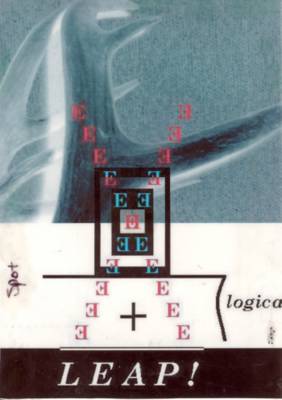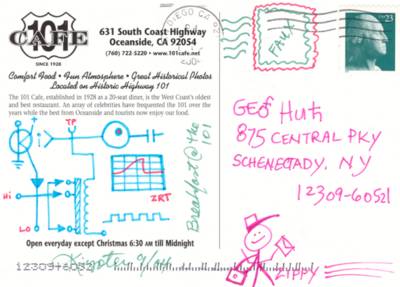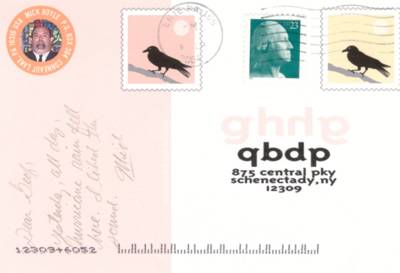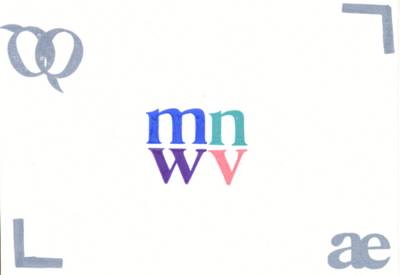Scott McDonald sent me an envelope, inside of which was a postcard and a letter explaining how he had left my street address off the postcard, had received it back from the post office, and then had misplaced it for almost a month. The card is printed on inkjet transparency film, which gives the color more liveliness than paper. Upon this film he prints one of his wild mathemaku (a form of visual poetry created by Bob Grumman).

Scott McDonald, "LEAP!" (10 Aug 2004)
kiyotei had breakfast on Highway 101, and all I got was this schematic diagram that surreptitiously spells out his name! (I can’t decide if the lower half spells out anything, but I have a guess.)

kiyotei, "Breakfast @ the 101" (Sep 2004)
Mick Boyle sends me a beautiful rendering of what I’m now calling the dbqpnacci sequence (that sequence that creates the names for all my publishing projects). I love the Escher-like overlappings of these perfectly balanced letterforms—especially in this typeface.

Mick Boyle, "pdbq" (Sep 2004)
On the obverse of the card, Mick takes my initials and turns them into a self-mirroring quasi-dbqpnacci form.

Mick Boyle, Card to ghhg (9 Sep 2004)
I was amazed by the variety of forms in the mailart, so I created yet another style for these artists and a few other lucky folks. As I sat in the camp at Caroga Lake today, fiddling with rubberstamps, I realized that I could almost-mirror “mn” with “wv” and then make both lines suggest words—suggest something of the place where I was then sitting.
I stamped this small concrete poem, “mn/wv,” on the white sides of some blank sheets of cardboard I found being discarded at work. (After adding the poem to the front, I realized the cards were ¼ of an inch too wide for me to mail it with a postcard stamp, so I trimmed each one by one. Once home, I trimmed all the remaining blank cards.) The reverse of the card is grey, but it served its purpose well, I filled one third with the addresses and stamps. Then I sat on the screen porch in the sun, with a slight cool breeze blowing over my naked toes, and wrote each correspondent a short note of dense green text.

Geof Huth, "mn/wv" (12 Sep 2004)
The following are the recipients of “mn/wv”:
After finishing the series, I decided that I needed to send my friend Dees Stribling one of these cards (since he might fathom and then enjoy the pun), so his card is the thirteenth of a series of twelve—or, as I told him, “the baker’s dozenth of a dozen.”
1/12 Ruth and Marvin Sackner
2/12 Bob Grumman
3/12 Roy Arenella
4/12 kiyotei
5/12 Scott McDonald
6/12 Mick Boyle
7/12 Scott Helmes
8/12 Studio 360, WNYC Radio, 1 Centre Street, 30th Floor, New York, NY 10007 (mailart project)
9/12 Qpidoremix
10/12 Luc Fierens
11/12 Erin Huth
12/12 qbdp
13/12 Dees and Yuriko Stribling
un violon d’ingres
8 comments:
Hi there,
Seems you are in touch with a few of my contacts as well. How small the electronic web sometimes seems to be....
nice to heva found your BLOG
Ruud Janssen (www.iuoma.org)
Ruud,
Thanks for your comments. I often visit your website as well!
Geof
I wish there were more mail art blogs like this. great work!
Hazel,
Thanks! Glad you enjoyed it.
Geof
This is really fun. More and More mail art blogs are poping up, and the comments are dialogues between mail-artists. With what has grown the last months someone could actually publish a very nice book. We should try to make this happen somehow. Of course my need to document things pops up now again.....
Ruud
Ruud,
I've noticed the genesis of more mailart blogs all of a sudden as well. Certainly, an interesting phenomenon.
Your need to document is like mine--but I've come to think that a need to document is a common trait in mailartists. Maybe we are all archivists after all.
Geof
There are certains things needed to become an archivist. One needs the space for it. I know of mail-artists that bhave little space and that is the reason that they recycle eveything......
Huge collections are build up everywhere. But the elctronic stuff. Is that arcjived as well? I wonder. Do you have digital material archived on CD's? For instance. Where is this short text archived? Only on this site, in the cache-files of search engines. For the time beoing surely. But in 10 years? The paper I received 25 years ago is still accesible. The diskettes I used in 1980 I already have thrown away since I am unable to read 5,25 inch diskettes nowadays, and also the magnethic information looses its shape over the years...... Documenting. It is a hell of a job. Archiving is much more easier. One just has to keep everything one receives......
Ruud,
Forgot to respond to this note. I have archives in all media, but we can't just save electronic stuff on some media. We need to make sure we can still read the media and still read the files on them. It's a hard job, and one I talk about for work all the time.
But, boy, is paper ever easier!
Geof
Post a Comment